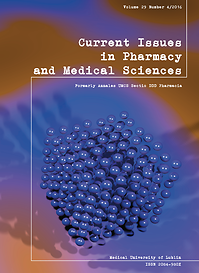Features of somatotype and body weight component composition in patients with acne: boys and girls of Podillya region of Ukraine
DOI:
https://doi.org/10.1515/cipms-2016-0020Słowa kluczowe:
somatotype components, body weight composition, boys, girls, acneAbstrakt
The article describes the differences in peculiarities of somatotype and body weight component composition in patients with acne, the study population being boys and girls of the Podillya region of Ukraine. In the study subjects, regardless of sex, body muscle mass, bone mass and the mesomorphic somatotype component of those with acne were significantly greater, while fat body mass indicators and the endomorphic somatotype component was smaller – in comparison to that of non-afflicted subjects of similar gender. Regarding the ectomorphic component of somatotype, between the surveyed groups of those with and without acne, whether male or female, no significant differences were revealed. For all indicators, whether the somatotype components or the component composition of body weight, between groups of boys or girls with different degrees of severity of acne, again no significant differences were established.
Bibliografia
1. Kornetov N.A. Clinical anthropology – methodological basis for a holistic approach in medicine. Proceedings of the international conference “Current issues and achievements of modern anthropologists”, Novosibirsk, 2006.
2. Nikitiuk B.A., Moroz V.M., Nikitiuk D.B. Theory and practice of integrative anthropology. Essays. Kiev-Vinnitsa: Zdorov’ya, 301, 1998.
3. Samtsov A.V. Acne and acneforme dermatosis. Monograph M. : OOO “YUTKOM”, 288, 2009.
4. Szabó K., Kemény L. Studying the genetic predisposing factors in the pathogenesis of acne vulgaris. Human Immunology, 72, 9, 2011.
5. Kobileva N.G., Prohorenkov V.I. Ethnic peculiarities of the state of the skin in health and acne. Siberian Journal of Dermatology and Venereology, 2, 10, 2009.
6. Koynosov A.P. Clinical and constitutional studies in dermatology. Tutorial. Tyumen, Shadrinsk, 135, 2010.
7. Al-Gindan Y.Y. et al. Derivation and validation of simple anthropometric equations to predict adipose tissue mass and total fat mass with MRI as the reference method. British Journal of Nutrition. 114, 11, 2015. [Web of Science]
8. Richard Pierson N. Jr. Quality of the Body Cell Mass: Body Composition in the Third Millennium Serono Symposia USA. Springer Science & Business Media, 345, 2012.
9. Shaparenko P.P. Anthropometry. Vinnitsa, 71, 2000.
10. Carter J.E.L. The Heath-Carter anthropometric somatotype. Instruction Manual. Surrey, Canada: TeP and Rosscraft, 154, 2002.
11. Nikolic S. et al. Analysis of body mass components in national club football players in republic of Macedonia. Medicine Archives. 68, 3, 2014.
12. Gaydash A.A. et al. The structure of the extracellular matrix of the skin of various human somatotypes according to the data of atomic force microscopy. Siberian Medical Journal. 5, 2011.
13. Hans Fecht J., Kai Brühne. Carbon-based Nanomaterials and Hybrids: Synthesis, Properties, and Commercial Applications. CRC Press, 220, 2014.
14. Thierry Ondarçuhu, Jean-Pierre Aimé. Nanoscale Liquid Interfaces: Wetting, Patterning and Force Microscopy at the Molecular Scale. CRC Press, 780, 2013.
15. Ke-Li Han, Guang-Jiu Zhao. Hydrogen Bonding and Transfer in the Excited State. John Wiley & Sons, 970, 2011.
Pobrania
Opublikowane
Numer
Dział
Licencja
Prawa autorskie (c) 2016 Autorzy

Praca jest udostępniana na licencji Creative Commons Attribution-NonCommercial-NoDerivatives 3.0 Unported License.


